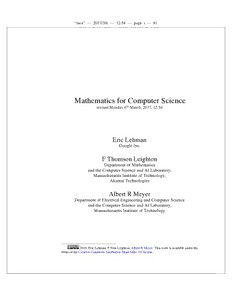Table Of Content“mcs” — 2017/3/6 — 12:54 — page i — #1
Mathematics for Computer Science
revisedMonday6th March,2017,12:54
Eric Lehman
GoogleInc.
F Thomson Leighton
DepartmentofMathematics
andtheComputerScienceandAILaboratory,
MassachussettsInstituteofTechnology;
AkamaiTechnologies
Albert R Meyer
DepartmentofElectricalEngineeringandComputerScience
andtheComputerScienceandAILaboratory,
MassachussettsInstituteofTechnology
2016,EricLehman,FTomLeighton,AlbertRMeyer.Thisworkisavailableunderthe
termsoftheCreativeCommonsAttribution-ShareAlike3.0license.
“mcs” — 2017/3/6 — 12:54 — page ii — #2
“mcs” — 2017/3/6 — 12:54 — page iii — #3
Contents
I Proofs
Introduction 3
0.1 References 4
1 WhatisaProof? 5
1.1 Propositions 5
1.2 Predicates 8
1.3 TheAxiomaticMethod 8
1.4 OurAxioms 9
1.5 ProvinganImplication 11
1.6 Provingan“IfandOnlyIf” 13
1.7 ProofbyCases 15
1.8 ProofbyContradiction 16
1.9 Good ProofsinPractice 17
1.10 References 19
2 TheWellOrderingPrinciple 29
2.1 WellOrderingProofs 29
2.2 TemplateforWellOrderingProofs 30
2.3 FactoringintoPrimes 32
2.4 WellOrderedSets 33
3 LogicalFormulas 45
3.1 PropositionsfromPropositions 46
3.2 PropositionalLogicinComputerPrograms 50
3.3 EquivalenceandValidity 52
3.4 TheAlgebraofPropositions 55
3.5 TheSATProblem 60
3.6 PredicateFormulas 61
3.7 References 66
4 MathematicalDataTypes 91
4.1 Sets 91
4.2 Sequences 96
4.3 Functions 97
4.4 BinaryRelations 99
4.5 FiniteCardinality 103
“mcs” — 2017/3/6 — 12:54 — page iv — #4
iv Contents
5 Induction 123
5.1 OrdinaryInduction 123
5.2 StrongInduction 132
5.3 StrongInductionvs.Inductionvs.WellOrdering 139
6 StateMachines 159
6.1 StatesandTransitions 159
6.2 TheInvariantPrinciple 160
6.3 PartialCorrectness&Termination 168
6.4 TheStableMarriageProblem 173
7 RecursiveDataTypes 203
7.1 RecursiveDefinitionsandStructuralInduction 203
7.2 StringsofMatchedBrackets 207
7.3 RecursiveFunctionsonNonnegativeIntegers 211
7.4 ArithmeticExpressions 213
7.5 InductioninComputerScience 218
8 InfiniteSets 245
8.1 InfiniteCardinality 246
8.2 TheHaltingProblem 255
8.3 TheLogicofSets 259
8.4 DoesAllThisReallyWork? 262
II Structures
Introduction 287
9 NumberTheory 289
9.1 Divisibility 289
9.2 TheGreatestCommonDivisor 294
9.3 PrimeMysteries 301
9.4 TheFundamentalTheoremofArithmetic 303
9.5 AlanTuring 306
9.6 ModularArithmetic 310
9.7 RemainderArithmetic 312
9.8 Turing’sCode(Version2.0) 315
9.9 MultiplicativeInversesandCancelling 317
9.10 Euler’sTheorem 321
9.11 RSAPublicKeyEncryption 326
9.12 WhathasSATgottodowithit? 328
“mcs” — 2017/3/6 — 12:54 — page v — #5
v Contents
9.13 References 329
10 Directedgraphs&PartialOrders 367
10.1 VertexDegrees 369
10.2 WalksandPaths 370
10.3 AdjacencyMatrices 373
10.4 WalkRelations 376
10.5 DirectedAcyclicGraphs&Scheduling 377
10.6 PartialOrders 385
10.7 RepresentingPartialOrdersbySetContainment 389
10.8 LinearOrders 390
10.9 ProductOrders 390
10.10EquivalenceRelations 391
10.11SummaryofRelationalProperties 393
11 CommunicationNetworks 425
11.1 Routing 425
11.2 RoutingMeasures 426
11.3 NetworkDesigns 429
12 SimpleGraphs 445
12.1 VertexAdjacencyandDegrees 445
12.2 SexualDemographicsinAmerica 447
12.3 SomeCommonGraphs 449
12.4 Isomorphism 451
12.5 BipartiteGraphs&Matchings 453
12.6 Coloring 458
12.7 SimpleWalks 463
12.8 Connectivity 465
12.9 Forests&Trees 470
12.10References 478
13 PlanarGraphs 517
13.1 DrawingGraphsinthePlane 517
13.2 DefinitionsofPlanarGraphs 517
13.3 Euler’sFormula 528
13.4 BoundingtheNumberofEdgesinaPlanarGraph 529
13.5 ReturningtoK andK 530
5 3;3
13.6 ColoringPlanarGraphs 531
13.7 ClassifyingPolyhedra 533
13.8 AnotherCharacterizationforPlanarGraphs 536
“mcs” — 2017/3/6 — 12:54 — page vi — #6
vi Contents
III Counting
Introduction 545
14 SumsandAsymptotics 547
14.1 TheValueofanAnnuity 548
14.2 SumsofPowers 554
14.3 ApproximatingSums 556
14.4 HangingOutOvertheEdge 560
14.5 Products 566
14.6 DoubleTrouble 569
14.7 AsymptoticNotation 572
15 CardinalityRules 597
15.1 CountingOneThingbyCountingAnother 597
15.2 CountingSequences 598
15.3 TheGeneralizedProductRule 601
15.4 TheDivisionRule 605
15.5 CountingSubsets 608
15.6 SequenceswithRepetitions 610
15.7 CountingPractice: PokerHands 613
15.8 ThePigeonholePrinciple 618
15.9 Inclusion-Exclusion 627
15.10CombinatorialProofs 633
15.11References 637
16 GeneratingFunctions 675
16.1 InfiniteSeries 675
16.2 CountingwithGeneratingFunctions 677
16.3 PartialFractions 683
16.4 SolvingLinearRecurrences 686
16.5 FormalPowerSeries 691
16.6 References 694
IV Probability
Introduction 713
17 EventsandProbabilitySpaces 715
17.1 Let’sMakeaDeal 715
“mcs” — 2017/3/6 — 12:54 — page vii — #7
vii Contents
17.2 TheFourStepMethod 716
17.3 StrangeDice 725
17.4 TheBirthdayPrinciple 732
17.5 SetTheoryandProbability 734
17.6 References 738
18 ConditionalProbability 747
18.1 MontyHallConfusion 747
18.2 DefinitionandNotation 748
18.3 TheFour-StepMethodforConditionalProbability 750
18.4 WhyTreeDiagramsWork 752
18.5 TheLawofTotalProbability 760
18.6 Simpson’sParadox 762
18.7 Independence 764
18.8 MutualIndependence 766
18.9 ProbabilityversusConfidence 770
19 RandomVariables 799
19.1 RandomVariableExamples 799
19.2 Independence 801
19.3 DistributionFunctions 802
19.4 GreatExpectations 811
19.5 LinearityofExpectation 822
20 DeviationfromtheMean 853
20.1 Markov’sTheorem 853
20.2 Chebyshev’sTheorem 856
20.3 PropertiesofVariance 860
20.4 EstimationbyRandomSampling 866
20.5 ConfidenceinanEstimation 869
20.6 SumsofRandomVariables 871
20.7 ReallyGreatExpectations 880
21 RandomWalks 905
21.1 Gambler’sRuin 905
21.2 RandomWalksonGraphs 915
V Recurrences
Introduction 933
22 Recurrences 935
“mcs” — 2017/3/6 — 12:54 — page viii — #8
viii Contents
22.1 TheTowersofHanoi 935
22.2 MergeSort 938
22.3 LinearRecurrences 942
22.4 Divide-and-ConquerRecurrences 949
22.5 AFeelforRecurrences 956
Bibliography 963
GlossaryofSymbols 967
Index 971
“mcs” — 2017/3/6 — 12:54 — page 1 — #9
I Proofs
“mcs” — 2017/3/6 — 12:54 — page 2 — #10

